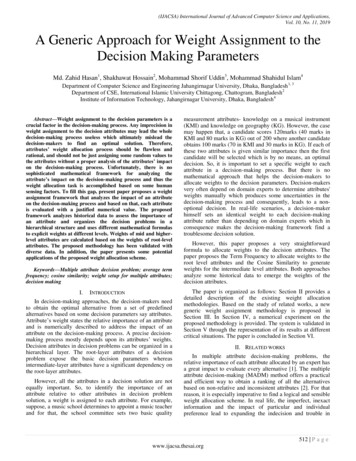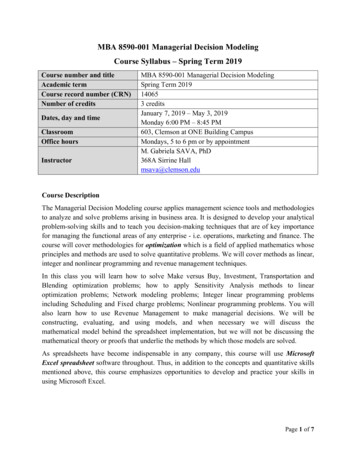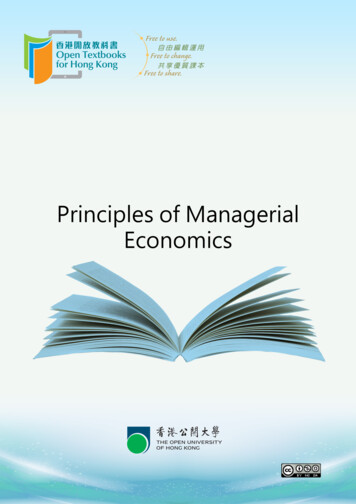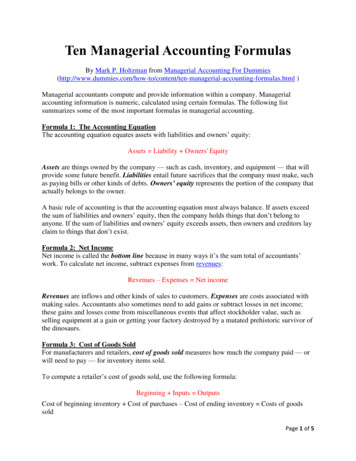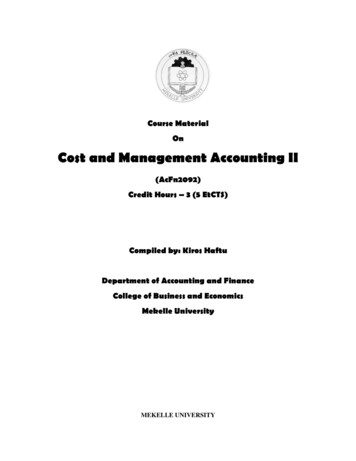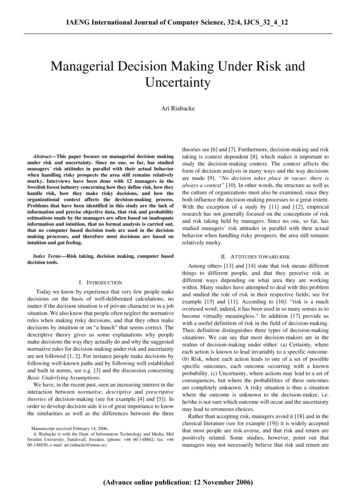
Transcription
IAENG International Journal of Computer Science, 32:4, IJCS 32 4 12Managerial Decision Making Under Risk andUncertaintyAri RiabackeAbstract—This paper focuses on managerial decision makingunder risk and uncertainty. Since no one, so far, has studiedmanagers risk attitudes in parallel with their actual behaviorwhen handling risky prospects the area still remains relativelymurky. Interviews have been done with 12 managers in theSwedish forest industry concerning how they define risk, how theyhandle risk, how they make risky decisions, and how theorganizational context affects the decision-making process.Problems that have been identified in this study are the lack ofinformation and precise objective data, that risk and probabilityestimations made by the managers are often based on inadequateinformation and intuition, that no formal analysis is carried out,that no computer based decision tools are used in the decisionmaking processes, and therefore most decisions are based onintuition and gut feeling.Index Terms—Risk taking, decision making, computer baseddecision tools.I. INTRODUCTIONToday we know by experience that very few people makedecisions on the basis of well-deliberated calculations, nomatter if the decision situation is of private character or in a jobsituation. We also know that people often neglect the normativerules when making risky decisions, and that they often makedecisions by intuition or on “a hunch” that seems correct. Thedescriptive theory gives us some explanations why peoplemake decisions the way they actually do and why the suggestednormative rules for decision-making under risk and uncertaintyare not followed [1, 2]. For instance people make decisions byfollowing well-known paths and by following well establishedand built in norms, see e.g. [3] and the discussion concerningBasic Underlying Assumptions.We have, in the recent past, seen an increasing interest in theinteraction between normative, descriptive and prescriptivetheories of decision-making (see for example [4] and [5]). Inorder to develop decision aids it is of great importance to knowthe similarities as well as the differences between the threeManunscript received February 14, 2006.A. Riabacke is with the Dept. of Information Technology and Media, MidSweden University, Sundsvall, Sweden. (phone: 46 60-148862; fax: 4660-148830; e-mail: ari.riabacke@miun.se).theories see [6] and [7]. Furthermore, decision-making and risktaking is context dependent [8], which makes it important tostudy the decision-making context. The context affects theform of decision analysis in many ways and the way decisionsare made [9]. “No decision takes place in vacuo: there isalways a context” [10]. In other words, the structure as well asthe culture of organizations must also be examined, since theyboth influence the decision-making processes to a great extent.With the exception of a study by [11] and [12], empiricalresearch has not generally focused on the conceptions of riskand risk taking held by managers. Since no one, so far, hasstudied managers risk attitudes in parallel with their actualbehavior when handling risky prospects, the area still remainsrelatively murky.II. ATTITUDES TOWARD RISKAmong others [13] and [14] state that risk means differentthings to different people, and that they perceive risk indifferent ways depending on what area they are workingwithin. Many studies have attempted to deal with this problemand studied the role of risk in their respective fields; see forexample [15] and [11]. According to [16]: “risk is a muchoverused word; indeed, it has been used in so many senses as tobecome virtually meaningless.” In addition [17] provide uswith a useful definition of risk in the field of decision-making.Their definition distinguishes three types of decision-makingsituations. We can say that most decision-makers are in therealms of decision-making under either: (a) Certainty, whereeach action is known to lead invariably to a specific outcome.(b) Risk, where each action leads to one of a set of possiblespecific outcomes, each outcome occurring with a knownprobability. (c) Uncertainty, where actions may lead to a set ofconsequences, but where the probabilities of these outcomesare completely unknown. A risky situation is thus a situationwhere the outcome is unknown to the decision-maker, i.e.he/she is not sure which outcome will occur and the uncertaintymay lead to erroneous choices.Rather than accepting risk, managers avoid it [18] and in theclassical literature (see for example [19]) it is widely acceptedthat most people are risk-averse, and that risk and return arepositively related. Some studies, however, point out thatmanagers may not necessarily believe that risk and return are(Advance online publication: 12 November 2006)
positively related [20] and in a study, made by [12], 73% of themanagers believed that risk was manageable. According to [21]one of the major tenets of portfolio analysis is that risk andreturn are positively correlated, i.e. if a person wants a higherreturn, he should, on average, also take a higher risk. However,others (e.g. [22] and [23]), show that there may be a negativecorrelation between accounting measures of risk and return. Inthe study by [12], 43% of the managers felt that risk and returnwere related in one way or another and 48% felt that the twowere not necessarily related. Several studies show thatmanagers do not accept that the risks they face are inherent inthe situation, and avoid accepting risk by considering it assubject to control [24]. Rather, they believe that using skills tocontrol the dangers can reduce risk. In the study by [12] 73% ofthe managers believed that risk was manageable and saw risk ascontrollable. They also made a definite distinction betweengambling (where the odds are exogenously determined anduncontrollable) and risk taking (where skill or information canreduce the uncertainty) (ibid., p.73).To be able to improve the managerial decision-making byproviding decision makers with prescriptive decision aids weneed to interview decision makers concerning their way ofmaking decisions. In addition, we must study the organizationand the decision-making context where the decision-makingtakes place; an aspect that none the less is often neglected.This study aims to examine how managers in the Swedishforest industry define risk, how they handle risk, how theymake risky decisions and how the organizational contextaffects the decision-making process. So, the main problems tobe examined are; how do managers make real decisions andwhat type of problems do they actually experience whendealing with decision situations involving risk and uncertainty?III. THE STUDY OUTLINEThis study was carried out in two major Swedish forestcompanies and includes interviews with twelve managers. Theresearch method can be characterized as descriptive andexplorative. The semi-structured interviews were based on aninterview protocol, and the respondents received the interviewprotocol in advance. The protocol served as the basis for theinterviews and “probing” was used whenever it was necessaryin order to gain more information from the respondents. Eachinterview lasted between two and three hours. The interviewstudy is a two-stage study, the first stage consists of theinterviews and the second stage consists of the questionnaire inwhich the managers choose from different risky prospects. Inthe first half of the interview study, ideas of [12] serves as abasis. The amount of money in the offered prospect varied,since the aim was to examine if the behavior of the managerschanged when the sums increased. The participants in the studywere not chosen at random. Instead, an effort was made tosecure a broad spectrum of managers from many differentspheres of activities. Since there are relatively few respondentsparticipating in the study, the results are not generallyapplicable.IV. THE STUDYA. WHAT IS RISK?When asking the managers how they defined risk, most ofthem distinguished between different types of risks, such as firerisk, financial risk, technical risk, commercial risk, andinvestment risk. They said that a risky situation is a situationwhere the outcome is unknown to the decision-maker, i.e.he/she is not sure which outcome will occur and the uncertaintyleads to erroneous choices. When the managers were asked todescribe a risky decision they had recently made, or a riskysituation they had been involved in, more than half of themassociated this with different kinds of investment activities anddivided them into such categories as (a) investing in newmachines and techniques, (b) acquisition of new companies, (c)development of new products and entering new markets.(a) They were uncertain about whether they would reach theexpected production speed within the scheduled time, if theywould be able to produce top quality paper, and the reliability ofthe new machines. One manager said, “New techniques arealways riskier than old techniques. So, we must decide if we, forexample, want to be first in a new market or the first with a newproduct, or if we should hold back for a while and enter themarket as number two. Another risky area pointed out by amanager was that they were very vulnerable concerning issuesrelated to information technology.(b) One problem that a manager did bring up is related to theacquisition of other companies. He said, “I do not think that wereally are aware of how to estimate different types of risk thatwe need to deal with.” He also said that even though the“mathematical part” of many problems was easily solved sincethey have figures concerning the cash flow, the potentialdevelopment and so on, they are still greatly governed by the“soft aspects” of the decision-making process. He also said thatthey often invest in projects that they believe will be goodinvestments, and that they do not only focus on figures or theinvestment index. Three others expressed the same sentimentsconcerning the acquisition of new companies by saying that theysometimes even ignore the figures they have and base theirdecisions on their “gut reaction”.(c) One example of risk, which is difficult to estimate andpredict, is when to leave an existing market. The risky elementin such a case is that once you have left a market you can notreturn. One manager, who refers to such a case concerningentering a new market with newspaper-paper, said, “Thesekinds of decisions are very unreliable.” Therefore, manydecisions of that type are based on subjective appraisals of thedecision-makers – not on any calculations. Regarding the futureinterest rates risk one of them said, “We used to consult a bankand some other institutions regarding these kinds of matters, butwe make the final decision by “gut feelings”, i.e., we choose thealternative that feels good.”
1) Risk and return – are they related?The managers in this study were asked their opinion withregard to the following argument, “When taking larger risksthere are expectations of larger returns.” Ten of them explicitlysaid that risk is related to profit in one way or another.Statements such as the following were made: “Higher risk mustresult in higher profit”, “Yes, everything is about maximizingthe return, and in order to do so we must take risks all the time”,“Higher risk corresponds to higher potential profit.” and “Ibelieve that if you are not willing to take any risk at all you willnot receive a good profit either.” However, although most ofthem agreed with the statement that there is a relationshipbetween risk and return, four of them said that it is important tominimize the risks and not take too great risk. Two of them alsosaid that they were no gamblers and therefore were very carefulwhen taking risks, which was the recurring statement duringthe interviews. All of them agreed to the statement that “if youdon’t take risks there will be no returns.” Four of them wereconvinced that it was necessary to take risks almost always –“otherwise nothing will get done” as one of them pointed out.Four of the managers regarded risk and uncertainty as almostthe same thing and thought that they are strongly correlated.Some statements made were: “For me there is a strong relationbetween risk and uncertainty, I cannot see any differencebetween them”, and “If you know all the necessary facts thenyou do not take any risk, but if you do not know all about thefuture, which you do not!, then you take a risk. Risk anduncertainty are thus correlated.” In the last quotation we alsofind a recurring statement, namely that uncertainty refers to afuture state. The opinion of four of the managers was thatuncertainty was the reason for the existence of risk. Accordingto them, the level of uncertainty could in many cases be reducedif the actual case was analyzed in an orderly fashion2) Dealing with riskThe managers were asked what they did when faced with aproblem that involves risk, and they had to rank the alternativesbelow;(a) Avoid taking risks (5,28)(b) Collect more information (1,68)(c) Check different aspects of the problem (1,86)(d) Actively work on the problem to reduce therisk (2,54)(e) Delay the decision (4,71)(f) Delegate the decision (5,50)(g) Other (specify)The responses are displayed in the right-hand column. Thesum is the average of the answers (1 was the most preferredalternative and 6 was the least preferred alternative).The pattern of how they try to tackle decision problemsinvolving risk was fairly clear. In order these were (b) collectmore information, (c) check different aspects of the problem,(d) actively work on the problem and in due time (e) delay thedecision. The majority of them agreed that taking risks wasnecessary for the organization. However, four of them stressedthat they would avoid taking risks if the consequences could be“catastrophic”, i.e. if the organization could not manage thesituation if it turned out wrong. An interesting statement madeby several of the managers was that if the financial status of thecompany was poor then they would avoid all kinds of risktaking.3) Can risk be managed?When asking the managers if they thought that risk could bemanaged all of them said yes. They said that risk could bemanaged if you have correct information, sufficient knowledgeabout the problem, and if you are experienced in the field itconcerns. Most of them, once more, emphasized the importanceof alternatives (b) Collect more information, (c) Check differentaspects of the problem, and (d) Actively work on the problem toreduce the risk. Five of the managers also mentioned that theyuse their intuition or feeling to decide what is right or wrong, inother words they make subjective estimations about future statesof the world. Other ways that the managers attempted to managethe risk included: buying insurance, thus reducing the consequences of a risk, carrying out a pilot-study before making decisions, using check-lists of points to take into consideration whenmaking decisions, “sign-away” at least a part of the risk when for examplebuying a new machine (i.e. let the supplier take part of therisk and make this clear in the purchase contract).The risk estimates made by the managers were often based onwhat they identified as experience and intuition. Only one of themanagers explicitly expressed that he tried to calculate andquantify the risk.4) Is it possible to identify risk-prone and risk-aversepersons?According to five of the respondents risk-prone people arethose who want to make progress and go forward and three ofthem also said that risk-prone people work more independentlythan others do. Several of the managers considered risk-pronepersons as those who are willing to make a decision withouthaving “everything” perfectly clear. Other characteristics thatwere identified among risk-prone individuals: their risk behavior has more to do with their personality,and less with their background and education, people “who are risk-prone are not afraid of makingmistakes” people higher up in the organization were morerisk-prone.An interesting angle is that, even though both risk-prone andrisk-averse behavior are desirable qualities in differentsituations, the managers thought that risk-prone behavior was
something positive and that risk-averse behavior wassomething negative. For instance, one manager said that “arisk-prone person is someone who really wants to makeprogress and that is the kind of people companies are lookingfor.” Risk-averse people, on the other hand, were identified asthose who would “rather be safe than sorry”, and three of themanagers said that many people in the forest industry belong tothis category. What do the managers think of themselves - arethey risk prone or risk averse? Two of them said that they donot like risk taking, four of them said they consider themselvesneither one way nor the other, and finally the remaining sixstated that they like risk taking.5) Do the managers use any computer-based decision aidswhen working with risk estimations and/or decisionproblems?None of them used, or had ever used, any kind ofcomputer-based decision-tool or program. However, after someprobing it appeared that one of them sometimes did use Excelwhen he made some risk estimations regarding financial risks.A couple of the others said that they sometimes use Excel formodeling when doing investment calculations and also whenfollowing up as to whether investments had succeeded. Why dothey not make more use of computers when making decisionsand handling risk? One of the very top managers said “I havenever ever, in any company, in any council or in any othersituation, used any kind of computer based decision aid. I thinkthat many people try to take the easy way and that theytherefore do not spend time learning how to use such decisiontools – which is a pity since I think it could be advantageous inmany situations.”B. THE DECISION MAKING CONTEXTThe managers in this study were asked, “How do youperceive the structure of the organization?”(a) Mechanistic (Bureaucracy) with highly centralizeddecision-making(b) Organic (Adhocracy) with decentralized decisionmaking(c) OtherThe answers they gave were only in one single case just (a),(b) or (c). Several of them thought that the structure is a mixtureof the alternatives offered and three of them said that it issomething between (a) and (b). Three others said that it is (b) orat least on its way towards (b) and one of these three said “thedecision-making becomes more and more decentralized, andthere has been a lot of progress made during the past ten-years.”Half of the respondents, irrespective of whether they chose (a)or (b), had one opinion in common, namely that they agreedthat decentralized decision-making was only true up to a certainlevel, i.e. that most of the important decisions where madehigher up in the hierarchy. One manager said “the organizationis organic and decentralized at the factory level , but verybureaucratic above that level – which is unpleasant.”Moreover, one of the middle level managers said that “many ofus are afraid of making decisions that daddy perhaps maydisapprove of.” Similar “feelings” were expressed by otherswho said that the forest industry, by tradition, has been veryhierarchical and that you must always be aware of what peopleabove your level like or dislike. Another observation made inthis study was that people at the middle management level didnot, to the same extent, think that the decision-making in theorganization is decentralized as those higher up in thehierarchy. Thus, we can see from this study that the managers’answers were not unanimous and that it was not possible to saywhether the studied organizations were mechanistic or organic.The organizations were rather, according to the managers, amixture of both. It could perhaps be explained by the fact thatseveral of the managers perceived the organizations as organicat the factory level, but on the other hand, as mechanistic at thetop level.The managers were also asked to choose between twoalternatives regarding the culture in the organization,concerning the level of trust in subordinates.The alternatives were:(a) Autocratic with a low level of trust in subordinates(b) Democratic with a high level of trust in subordinates(c) Other.A majority of them chose alternative (b), but once again,even those who had chosen alternative (b) said things thatreinforced the feeling that trust and commission were somehowlimited. A few examples of what they said are: “Relativelydemocratic decision-making, but the final decisions are alwaysmade higher up in the hierarchy”, “Democratic, yes, but notwhen it comes to the big decisions”, “The top man is the oneand only one in charge.” The managers were also asked aboutwhether they thought there were, or not, unconscious,taken-for-granted beliefs that guide the decision-makers insome way. Eight of them said that there definitely were more ofunconscious and taken-for-granted beliefs that guided themwhen they made different kinds of decisions. Three of themmade statements such as the following: “There are somepatterns that implicitly guide people to act in some ways as italways has been done ”, “Yes, there is definitely a built-inculture that tells people what is right and what is wrong” and “Ithink we have quite a lot built into the walls , a lot of unwrittenrules that guide people in their decision-making.” Three of theother managers talked about discipline and the importance ofadapting to the organizational norms. One of them said thatmany of the workers had become very disciplined and thereason was, according to him, that either the workers chose to“adapt the style” or leave/lose their job. He also added that “Weare free, to a large extent, to perform our job as we want – aslong as it fits in to the built in norms.” Several of the mangersalso talked about the importance of “adapting the style”, tolearn what is right and what is wrong – even though most of therules are in unwritten form. Two of the top-level managers also
discussed these matters, and they agreed that it is important toemploy people who possess fundamental values that will suitthe business concept. Furthermore, they wanted to seeemployees who are willing to adapt to the style of the firm andwho suit the prevailing culture. One of them also said that“People have a tendency to follow a well-worn path in theorganization. Most of those who have worked in the companyfor a long time have adapted to the style of work and how tomake decisions – stated by others who have been working thereeven longer.”C. HOW DO THE MANAGERS CHOSE RISKYPROSPECTS?When studying how the managers chose from the riskyprospects in situations 1 – 3 (see appendix) we observed thecertainty effect. We can see that the majority of them preferredalternatives that are certain in preference to alternatives that aremerely probable, even though the expected value is higher inthe alternative that was not certain. We can thus see that theypreferred prospects that had a small variance or no variance atall. However, if the variance becomes larger in the prospects,such as from 100% to 25% in situations 2.1B and 2.2B, andfrom 80% to 20% in situations 2.1A and 2.1B, then they insteadchose the alternative that offered the largest possible outcome.This was, however, not always true. In situations 4.1 and 5.1 wecan see that if the difference in the variance was large then mostof them had a tendency to choose the alternative where winningwas more probable. We can, on the other hand, see in situations4.2 and 5.2 that if the probability of winning dramaticallydecreases and the chance of winning is possible but no longerprobable, then they chose the alternative that offered the largestgain. We can, at this stage, establish that the managers did notact in accordance with the expected utility rules.When replacing wins by losses we can observe aphenomenon called the reflection effect, i.e. that the riskaversion in the positive domain is replaced by risk seeking inthe negative domain, see situations 7–9. In situation 8.1 we canfor instance see that eight of the managers preferred the certainalternative (3.000.000 SEK, 100%) to the uncertain one(4.000.000 SEK, 80%). But, when looking at the loss domain,in situation 8.2, we can see that most of them were willing toaccept an 80% risk of losing -4.000.000 SEK in preference to acertain loss of -3.000.000 – although situation 8.2A has a lowerexpected value. In situation 10 we can observe the reflectioneffect in a different form. In the positive domains the majorityof them disregarded the fact that the probabilities are low if thepossible outcome is large. In the loss domain, on the otherhand, we can see that most of them chose the certain loss of-500 SEK in preference to -500.000 SEK with probability0,001%. Finally, in situations 11 and 12 we can observe theisolation effect. The isolation effect appeared when themajority of the managers made their choices, obviously nottaking into account the components that the alternatives shared,which in situation 11 is 100.000 SEK and in situation 12 is200.000 SEK. So, even though the offered prospects areidentical in final states, i.e. the expected value in all foursituations is 150.000 SEK, they proved to have risk-aversetendencies for positive prospects and risk-seeking tendenciesfor negative prospects. The results in situations 11 and 12 alsoexhibited framing problems, i.e. that people may choose inopposite ways and end up with contrary results when data arepresented in different, but mathematically equivalent, ways.So, what about the managers in this study – are theyrisk-prone or risk-averse? Half of them labeled themselves asrisk takers. Only two of them said that they are risk-averse andthe other four stated that they are somewhere in between. Whenanalyzing the choices they have made among the offeredprospects in the questionnaire we can, nevertheless, see that amajority prove to be risk-averse in positive domains, see e.g.the results in situations 1.1, 2.1, 3.1, 4.1, 5.1, 6.1, and 8.1. In thenegative domains, on the other hand, most of the managers tendto exhibit risk-prone behavior; see e.g. situations 7-9 where thereflection effect appears. Results from the study indicate thatthe managers do not act in a completely rational manner, nor inaccordance with the suggested normative rules.V. DISCUSSIONOne main problem that has been identified in this study is thelack of information and precise objective data. The risk andprobability estimations made by the managers are thereforeoften based on inadequate information and intuition.Furthermore, many of the managers said that they did not havethe necessary skills to estimate different types of risks and thatthey therefore make their decisions based on intuition and gutfeeling. Most of the managers also pointed out the lack ofinformation as a source of risk and uncertainty. Moreover, allof them thought that risk could be managed if one has thecorrect information and good knowledge about the problem.Ten of them explicitly said that risk is related to profit in oneway or another, and all twelve of them agreed with thestatement that “if you don’t take risks there will be no returns.”The managers were also asked to choose between twoalternatives about the culture in the organization, as to whetherthe level of trust in subordinates was low or high. Most of themdid choose the alternative that expressed that the organization isorganic and that the decision-making in the organization wasdecentralized. But, once again many of them said that thedecentralized decision-making was only partly true. Most ofthem said that there were a lot of unwritten rules built into theculture and three of them said things such as: “there are somepatterns that implicitly guide people to act in some ways - as italways has been done.” When asking the managers how theyperceived the structure of the organization most of them agreedthat it is a mixture of a bureaucratic and an organic organizationwith a mixture of centralized and decentralized decisionmaking. This question is crucial for many reasons since thestructure sets or creates the boundaries within which people areexpected to act, i.e. make their decisions.According to the managers it is relatively easy to identifywhether a person is risk-prone or risk-averse. Five of them saidthat risk-prone persons are those who want to make progress
and go forward, and three of them also said that risk-pronepersons work more independently than others – “they do nothave to ask about everything.” Other characteristics ofrisk-prone persons that the managers pointed out were; thecapacity to make rapid decisions, the ability to make decisionswithout having “everything” perfectly clear, and thatrisk-prone persons are not afraid of making mistakes. Incontrast to the opinions about the risk-prone persons therisk-averse persons were labeled as those who “complain aboutinnovations”, and as those “who do not like any kind ofchange.” And while risk-prone persons were perceived as thosewho could make decisions without having control ofeverything, risk-averse persons were, according to two of themanagers, those who wanted to have control of everythingbefore making a decision. Interestingly, however, it wasobserved that risk-prone persons were regarded as the “desiredones”, and that the risk-averse were regarded as the “undesiredones”. For instance, one of the managers said, “It is alwaysbetter to work with persons who take risks in comparison tothose who try to avoid risk in every situation.” One of themsaid, “A risk-prone person is someone who really wants tomake progress and that is the kind of person companies arelooking for.”VI. CONCLUSIONSConclusively, the managers did not act in accordance withsuggested normative rules, explicitly expressed their inabilityto handle many risky situations due to lack of information andexpressed their fear of doing something wrong, e
Abstract—This paper focuses on managerial decision making under risk and uncertainty. Since no one, so far, has studied managers risk attitudes in parallel with their actual behavior when handling risky prospects the area still remains relatively


